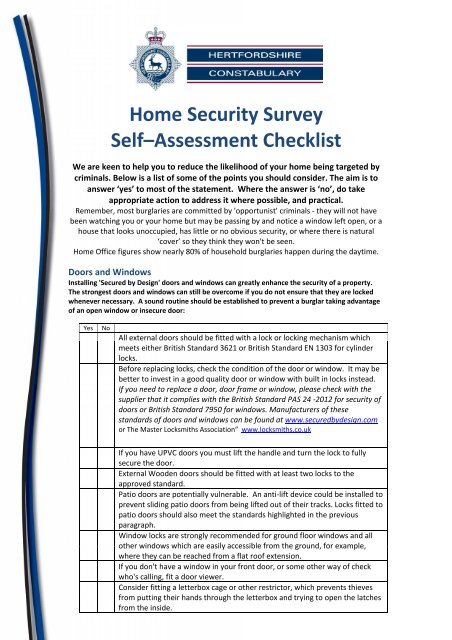Home Security Survey Self-assesment-1
Home Security Survey Self-assesment-1
Home Security Survey Self-assesment-1
You also want an ePaper? Increase the reach of your titles
YUMPU automatically turns print PDFs into web optimized ePapers that Google loves.
<strong>Home</strong> <strong>Security</strong> <strong>Survey</strong><br />
<strong>Self</strong>–Assessment Checklist<br />
We are keen to help you to reduce the likelihood of your home being targeted by<br />
criminals. Below is a list of some of the points you should consider. The aim is to<br />
answer ‘yes’ to most of the statement. Where the answer is ‘no’, do take<br />
appropriate action to address it where possible, and practical.<br />
Remember, most burglaries are committed by 'opportunist' criminals ‐ they will not have<br />
been watching you or your home but may be passing by and notice a window left open, or a<br />
house that looks unoccupied, has little or no obvious security, or where there is natural<br />
‘cover’ so they think they won't be seen.<br />
<strong>Home</strong> Office figures show nearly 80% of household burglaries happen during the daytime.<br />
Doors and Windows<br />
Installing 'Secured by Design' doors and windows can greatly enhance the security of a property.<br />
The strongest doors and windows can still be overcome if you do not ensure that they are locked<br />
whenever necessary. A sound routine should be established to prevent a burglar taking advantage<br />
of an open window or insecure door:<br />
Yes<br />
No<br />
All external doors should be fitted with a lock or locking mechanism which<br />
meets either British Standard 3621 or British Standard EN 1303 for cylinder<br />
locks.<br />
Before replacing locks, check the condition of the door or window. It may be<br />
better to invest in a good quality door or window with built in locks instead.<br />
If you need to replace a door, door frame or window, please check with the<br />
supplier that it complies with the British Standard PAS 24 ‐2012 for security of<br />
doors or British Standard 7950 for windows. Manufacturers of these<br />
standards of doors and windows can be found at www.securedbydesign.com<br />
or The Master Locksmiths Association” www.locksmiths.co.uk<br />
If you have UPVC doors you must lift the handle and turn the lock to fully<br />
secure the door.<br />
External Wooden doors should be fitted with at least two locks to the<br />
approved standard.<br />
Patio doors are potentially vulnerable. An anti‐lift device could be installed to<br />
prevent sliding patio doors from being lifted out of their tracks. Locks fitted to<br />
patio doors should also meet the standards highlighted in the previous<br />
paragraph.<br />
Window locks are strongly recommended for ground floor windows and all<br />
other windows which are easily accessible from the ground, for example,<br />
where they can be reached from a flat roof extension.<br />
If you don't have a window in your front door, or some other way of check<br />
who's calling, fit a door viewer.<br />
Consider fitting a letterbox cage or other restrictor, which prevents thieves<br />
from putting their hands through the letterbox and trying to open the latches<br />
from the inside.
Alarms<br />
Installing an alarm can help protect your home. There are two main types: audible only alarms and<br />
remote signalling alarms. Audible only alarms, when activated, can deter criminals from continuing<br />
further and can attract the attention of passers by and neighbours. Remote signalling alarms will<br />
be monitored by a monitoring centre who will notify the keyholder and, if registered with police,<br />
will inform police who will respond. Consider the following advice prior to fitting an alarm system:<br />
Audible alarms rely to some extent on there being someone in the vicinity to hear<br />
them, so in remote areas these alarms become less effective.<br />
The alarm box itself should be fixed to a prominent position on the outside of your<br />
home in order for it to act as a visual deterrent<br />
The alarm should meet any conditions set by your insurer<br />
Both types of alarm need to be regularly maintained as false activations can<br />
become an annoyance for your neighbours and a waste of police resources. Several<br />
false alarms from the same location may mean that police stop responding<br />
Marking Property<br />
Property is often recovered in circumstances which lead the police to suspect that it is stolen but it<br />
can be difficult to trace the rightful owner. <strong>Security</strong> marking is one way to help ensure that the<br />
police can return your property to you if it is found and to prove an offence has occurred, which<br />
may lead to a successful arrest and prosecution.<br />
Yes<br />
No<br />
Property should be marked using an ultra violet pen or by engraving<br />
Use your postcode and your house number in brackets. If your home does not<br />
have a number use the first two letters of your house name<br />
Always mark the back or underside of items.<br />
If you move home, security mark all your items again<br />
Items which cannot be marked by conventional means, such as jewellery,<br />
should be photographed. Place something next to the item to give an idea of<br />
scale (e.g. a coin) and keep the photographs in a safe place<br />
Register all your property for free on www.immobilise.com . If your phone,<br />
bike, computer or other registered item is lost or stolen, immobilise informs<br />
the police, insurers and the second hand trade and helps in the recovery of<br />
your property.<br />
Garages & Sheds<br />
Garages and sheds are often full of expensive tools, which are not only of value to a thief but ideal<br />
to use for breaking into your home!<br />
Yes<br />
No<br />
Never leave a garage or garden shed unlocked, especially if it has a<br />
connecting door to the house. A thief could get in and work on the door<br />
inside without being seen.<br />
Fit strong padlocks to shed and garage doors and make sure that the doors<br />
are solid enough not to be kicked in<br />
Lock ladders inside your garage or shed to stop a thief using them to reach<br />
upstairs windows. If there is no room in your garage or shed, chain or<br />
padlock them horizontally to a sturdy bracket on an outside wall<br />
Consider having lockable steel boxes fitted to the floor to store your tools in,<br />
or anchor posts fitted to the floor to secure larger tools and equipment<br />
Visibly and permanently mark property you keep in sheds and garages<br />
Consider purchasing a low cost shed/ garage stand alone alarm system
Gardens<br />
Yes<br />
No<br />
A thorny hedge along the boundary of your property can put thieves off. But<br />
make sure that passers‐by can still see the front of you home so that a<br />
burglar can't work without being seen<br />
Burglars don't like gravel, it's noisy to walk on<br />
Don't build pergolas, gazebos and so on too near to the house, they can help<br />
thieves reach upper windows<br />
Fencing<br />
Fencing is often the first line of defence when it comes to deterring a thief. It can offer a barrier<br />
which is either difficult to climb or helps define your property. Please consider the following<br />
advice:<br />
Yes<br />
No<br />
A low level fence and gate (approximately 1m high) at the front of your<br />
house allows any potential burglar to be seen by you and/or your neighbours<br />
At the rear of your house a fence approximately 1.8m high with an open<br />
trellis provides good security and is difficult to climb<br />
Strategic planting can also deter intruders. Consider planting Berberis,<br />
Blackthorn or Firethorn, or any other prickly bushes<br />
Gates leading to the rear of the house should ideally be in line with the front<br />
of your house. This increases the chances of you or your neighbours seeing<br />
someone trying to access them<br />
Lighting<br />
A burglar will do everything they can to avoid being seen. During the hours of darkness, a home<br />
without any lights on indicates not only that a home may be empty but that neighbours are unlikely<br />
to see anyone approaching. Consider the following lighting advice for your home:<br />
Yes<br />
No<br />
Either use ‘Dawn to Dusk’ lighting or PIR (passive infrared) lighting.<br />
PIR lighting activates when movement is detected, both these types of<br />
lighting can be very effective. Lighting your home sends out a clear message<br />
to the potential thief that the householder has put in place security<br />
measures. If you use PIR lights then ensure you positioning these lights on<br />
your house so that the sensor cannot be tampered with.<br />
Use timer switches on internal lights so they switch on and off automatically<br />
and make it look like there is someone at home<br />
When you’re away<br />
Yes No<br />
Cancel any milk or newspaper deliveries<br />
Cut the lawn before you go – if possible, ask someone to cut it again if you<br />
are away for some time<br />
Don't put your home address on luggage labels when travelling to your<br />
destination<br />
If you can, get a friend or neighbour to look after your home while you're<br />
away. Ask them to collect your post, draw your curtains at night and open<br />
them in the mornings, and generally make the place look lived ‐ in. Be<br />
prepared to do the same for them<br />
Avoid discussing holiday plans where strangers may hear details of your<br />
absence from home<br />
Consider leaving important documents and valuable items with other family<br />
members or a bank, or lock them in a safe<br />
If you normally leave valuable pedal cycles or similar items in your shed,<br />
consider putting them in the house for extra security while you are away<br />
For further crime prevention advice speak to your Safer Neighbourhood Team by calling 101<br />
or visit www.herts.police.uk
















